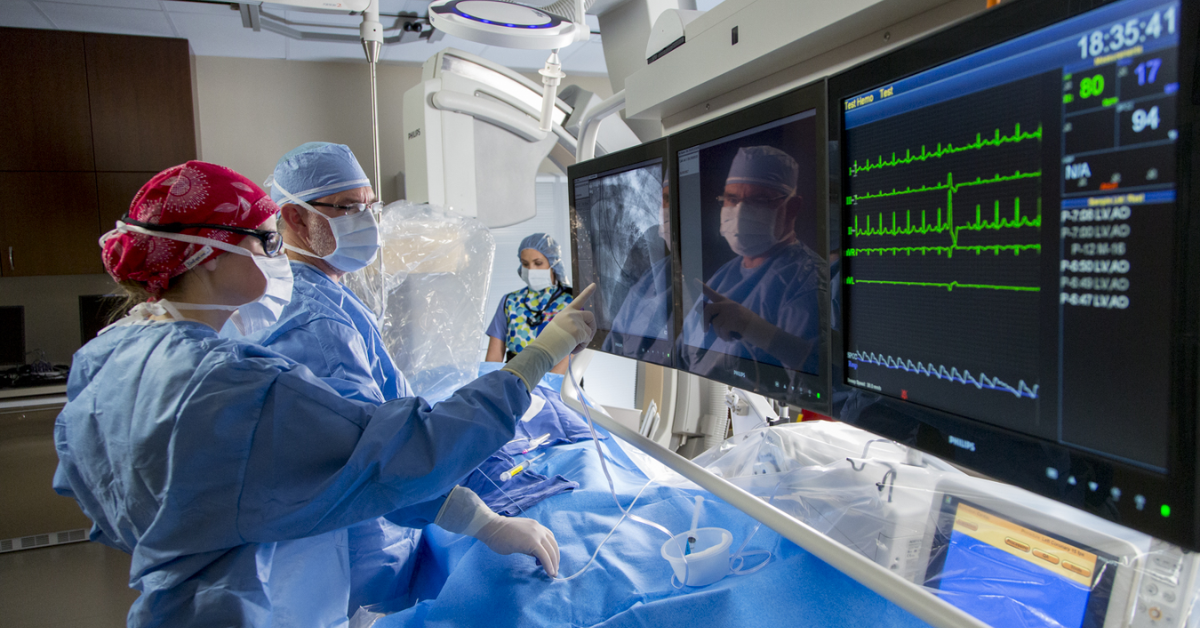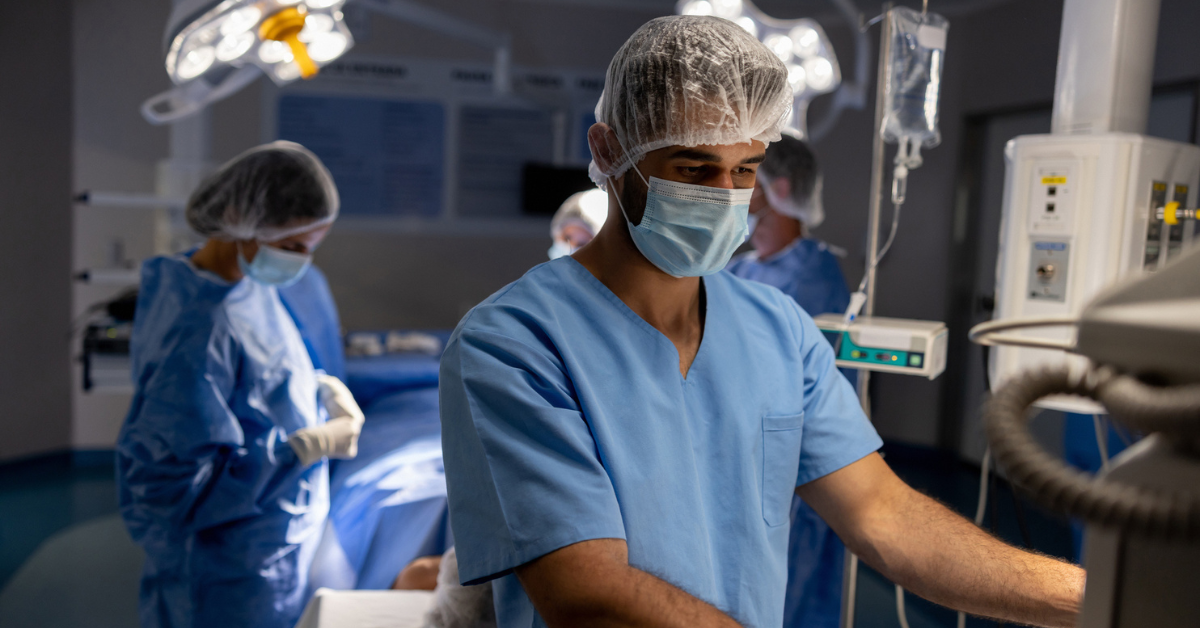City resident grateful for life-saving experience at Mary Rutan Hospital’s new cath lab
Article by Bellefontaine Examiner.

An energetic and spirited 89-year-old Bellefontaine resident is thankful today to be able to enjoy some of her favorite activities — from partaking of meals with her friends at the Logan County Friendly Senior Center to spending time with her family and tending to her flowers and tomato plants at her home — following a medical emergency she suffered on Christmas Day.
Patricia “Pat” Sebring and her son and daughter-in-law, Scott and Mary Sebring, said Mary Rutan Hospital’s new Level II Cardiac Catherization (cath) Laboratory played a huge role in getting Mrs. Sebring the immediate help she needed in December after she was rushed to the hospital’s Emergency Department.
Mrs. Sebring remembers she hadn’t slept well that morning, and by 4 or 5 a.m., she was awake and noticed she had started to sweat. Several hours later, she called her son and daughter-in-law, who is a nurse, to tell them about her symptoms, not thinking it was anything too serious at first.
“I was just trying to go about my morning and get things ready for our Christmas get-together a little later in the day,” she said of the incident just three days after her 89th birthday Dec. 22. “I got a little concerned that I was starting to sweat and I noticed my arm hurt, but thought it was just the way that I slept.”
“She called us and told us about what she was experiencing, complaining of fatigue, too, and we immediately became concerned,” her son said. “She otherwise has no health issues and is very healthy. Before all of this happened, she had never even been on any prescribed medication.”
Her family transported Mrs. Sebring to Mary Rutan Hospital’s Emergency Department, where the medical staff quickly identified that she was having a heart attack. The cardiologist promptly came to the ED to explain to her about the heart cath procedure.
Then within an hour of arriving at the hospital, she was upstairs in the cath lab, undergoing a procedure to place three stents.
“Within an hour, she was in surgery to have her stents placed,” Mr. Sebring said. “We were told if it this had happened just several months prior, before the cath lab opened here, she would have been flown out to another facility.
“When you’re experiencing a medical emergency like that, time is so crucial in saving a life, so we are so grateful that she was able to get the care she needed so quickly.”
Upon the opening of the Level II Cardiac Catherization Laboratory during September, Mary Rutan Hospital officials related the importance of offering this local access to quick intervention in emergency heart care.

“With the high volume of heart attack patients in our emergency department, we knew we needed a level II Cath Lab at Mary Rutan Hospital,” said Chad Ross, chief operations officer, who will assume of the role of president and chief executive officer upon the retirement of Mandy Goble on Aug. 30.
“Enabling our cardiologists to place stents and perform other cardiac interventions without having to transport patients during the most critical time for intervention. Time is muscle, so the faster patients can be treated, the greater the potential to save lives.”
According to the Centers for Disease Control and Prevention (CDC), heart disease is the leading cause of death for both men and women in the United States. Each year, approximately 805,000 Americans have a heart attack, which is one every 40 seconds.
The chances of surviving a heart attack improves significantly when emergency treatment begins quickly.
“When experiencing a heart attack, a delay in restoring blood flow to the heart muscle can result in greater damage and a higher likelihood of death,” explained Mary Rutan Hospital cardiologist Dr. Lou Vadlamani.
“With the opening of the Level II Cath Lab at Mary Rutan Hospital, we can diagnose and treat acute blockages in the coronary artery on-site, which gives the community increased access to potentially life-saving care. We now have the team and the technology to get this done quickly and without having to transfer the patient to another facility.”
In addition to emergency services, scheduled procedures will be available locally in the new Heart & Vascular Clinic, minimizing the need for patients to travel far from home. Services include interventional and diagnostic cardiac catheterization, peripheral vascular angiograms and intervention, pacemaker and defibrillator procedures, and loop recorder procedures.
Board Certified Interventional Cardiologists Dr. Vadlamani and Dr. Frederick Yturralde lead the cardiovascular team of trained interventional nurses and technologists at Mary Rutan Hospital. The new team approach integrates EMS, emergency department, cardiac catheterization lab and critical care services to provide efficient and effective responses to local cardiac emergencies.
“Achieving a Level II Cath Lab certification is a major step forward in the growth of our cardiovascular care,” said Michael Hoehn, Mary Rutan Hospital director of cardiology.
“With cardiologists available 24/7, we can respond quickly to patient needs for cardiac studies and interventional procedures, and our advanced technology will provide our cardiologists the in-lab imaging and diagnostic capabilities needed for today’s complex treatments.”
Hospital medical officials said symptoms of a heart attack include: chest pain, shortness of breath, pain or discomfort in the upper body, nausea, lightheadedness, and cold sweats. Individuals experiencing these symptoms should seek emergency medical care as quickly as possible.
Following Mrs. Sebring’s Christmas Day emergency and subsequent procedure in the cath lab, she spent three days in the hospital’s Intensive Care Unit before being discharged home.
She recently completed approximately five months of outpatient cardiac rehabilitation, with sessions twice a week at Mary Rutan Hospital, and now is back to her usual activities, including gardening and driving to the grocery store or to visit family and friends.
“I’m doing just about everything I used to do,” said the agile 89-year-old said. “It was so nice to be able to do all of my treatment close to home. There were many different exercise machines I would use during cardiac rehab, and I was glad to get all of my sessions in.”
The family time is precious following the loss of Mrs. Sebring’s husband, James “Jim” Sebring, on another holiday not too long ago, on Thanksgiving Day in 2019. Mrs. Sebring treasures her son and daughter-in-law and their canine companions, along with her grandchildren, Ryan and Marci.
“I’m most thankful for Scott and Mary being so close and looking after me,” she said.
For more information on the new cath lab and related services, visit www.maryrutan.org.
 company
company 
 (866) 755-7519
(866) 755-7519












